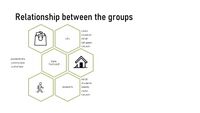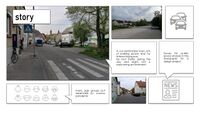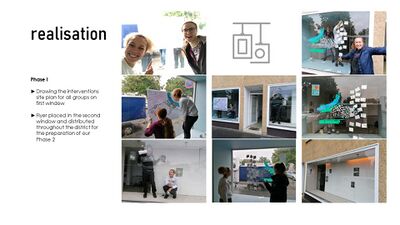LED2LEAP 2020 - Nuertingen Team 7: Difference between revisions
| Line 205: | Line 205: | ||
<gallery caption=" " widths="400px" heights="300px" perrow="3"> | <gallery caption=" " widths="400px" heights="300px" perrow="3"> | ||
File: | File:Realisation I 7D.JPG|''add a caption'' | ||
File:Realisation II 7D.JPG|''add a caption'' | |||
File:Realisation III 7D.JPG|''add a caption'' | |||
</gallery> | </gallery> | ||
Revision as of 12:12, 30 June 2020
>>>back to working groups overview
| Area | Klein-Tischardt | |
| Place | Nürtingen | |
| Country | Germany | |
| Topics | integration, interaction, sustainable environment | |
| Author(s) | Luisa Meyer-Böwing | |

| ||
Landscape Democracy Rationale
With the aim of successfully improving a district, we are confronting keywords. Those are innovation, sustainability and inclusion.
- Innovation means renewal: What are the offers? What is old and needs to be restored? What is missing? What does the district need?
- Sustainability means consideration for our natural resources: What ecosystems are in the described landscape? What does traffic mean for the district?
- Inclusion means that everyone belongs to the community: Which people live in the neighborhood? Who uses the district as a commuter, buyer or tourist? What are the social offers?
The task is to evaluate which of these keywords already exist in an existing district, wether they need to be improved or how you can reintegrate them into the district. A quarter improvement should be done with the residents, but it is important to listen not only to the stronger voices, but to all. In order to create a new sense of community from the very beginning, which continues until the renovations have been completed and every following generation.
Location and scope
- Location : Germany, Nürtingen 72622, Klein Tischardt
Phase A: Mapping your Community
Welcome to your community and its landscape
Kein-Tischardt is located directly below the historic centre of Nürtingen, between the rivers Neckar and Steinach and the Stuttgart - Tübingen railway line. There is affordable housing, various retailers and restaurants. The lack of public spaces and interaction problems between the residents are the shortcomings.
Groups of actors and stakeholders in your community
There are a variation of actors, including the city of Nürtingen with different institutions. In addition, restaurants, clubs and retailers are distributed throughout the district. All these stakeholders lack a meeting and communication area, which makes a clear infrastructure unreadable.
Relationships between your actors and groups
The groups are represented to be evenly important for the growth of the district. But the main players for in the district are the city of Nürtingen and the residents of Klein-Tischardt itself. Above all, there is the administration of the district, which is under the control of the city. As a result, all proposals are handled through the city counsil. The city tries to take into account all actors and sub-communities, but their wishes are only at one of the latter. What is important to all involved in Klein-Tischardt is the upgrading of the infrastructure and free space design.
Summary of your learnings from the transnational discussion panel on April 22
On April 22 you will present the PPT version of this first assignment to other seminar groups working in other geographical community contexts. Please give here a short summary of your learnings during this presentation, for example:
- That i should read myself on various alaytical processes in order to achieve a broad result. With different media and specific questions (Who might we?).
- I should better tune my content and presentation for better clarity. It is known to me that i know my district the best, but i have to be able to transmit my knowledge to others too.
- Other value schemes: any surprises?
- Constructive comments we received on our presentation
Theory reflection
The three sessions about 'Democratic Landscape Transformation' were very informativ, in the beginning to learn that there is no definitive formulation to landscape democracy or that there can be more than one possible solution can be quite helpful in finding motives to transform a landscape in a democratic principle. Also to understand the backstories of landscape and communities, with the understanding of the word democracy on its own has given me a new perspective in uncovering informations.
- Reflect on at least three readings from the first section 'Democratic Landscape Transformation
- From the LED2LEAP Session 1: wicked landscape democracy (Rittel, H.W.,& Webber, M. M. (1973). Dilemmas in a general theory of planning. Policy science) The posibility to evaluation different problems with these 7 descriptions, like with the corona pandemic.
- Scope: 250 words
References
- https://www.nuertingen.de/de/nuertingen-fuer-alle/rathaus-buergerservice/staedtische-aemter-einrichtungen/in-der-uebersicht
- https://www.nuertingen.de/de/nuertingen-fuer-alle/kultur-sport-freizeit/vereine/vereine
- individual information, given to us by the university for our design project in Klein-Tischardt
Phase B: Democratic Landscape Analysis and Assessment
The Scene in your Story of Analysis
- The district of Klein-Tischardt is mainly a housing area with 2.500 inhabitants. The open spaces are occupied by cars with traffic and parking.
- The cooperation between the city of Nürtingen lack in the abbility to communicate with its inhabitants. There are several services for the residents, that they can turn to. These services are very sparce and do not contribute to improving the local problems.
The Actors in your Story of Analysis
The main character is thomas müller, he is an it specialist. He recently moved back to nürtingen with his family, wife Birte and daughter Tina. Together with Thomas' parents, the city council and a few students from the university, his wife and daughter are among the minor characters.
The Story of Analysis
- Plot
Through the isolation of the corona pandemic, the Müller family becomes aware of how unattractive the public open spaces are and how much the community isolates itself from each other. Everyone thinks negatively, thinks only of themselves and neglects their surroundings. The Müllers want to do something about this process. With various posters and projections of old pictures on panells, throughout Klein-Tischardt, they want to make their community aware of what was once beautiful in their neighborhood. They call on their friends and the city to contribute their own and other current images to show the isolated inhabitants of Klein-Tischardt on the walls of their houses, to show that they are still there. Through organisational support of the students, the offer the students a projection screen of their own local projects to provide transparent planning for the residents. After a large participation, they decide to create different information centres for the neighbourhoods to offer the community a centre for self-determination and further development. In addition, film events of private recordings in the future, as well as other integrating and community events.
Reflect on your Story of Analysis
- Our tools should give the community a voluntary and independent basis for understanding and further development of the intervention. Everybody can contribute something different, it is a changeable way to share ideas with others by working with emotions and creativity and getting them reflected back.
- But we are not looking for a perfect story, a successful story also consists of defeats and setbacks from which one can learn. There is no To Doo list of things you need to succeed. This also makes the result more understandable and human.
- In the end a growing community structure should be created which is able to transport itself to the outside world to strengthen the interest in Klein-Tischardt and its inhabitants.
Phase C: Collaborative Visioning and Goal Setting
The Scene in your Story of Visioning
There is a large number of open spaces in Klein-Tischardt that are not attractive and meaningful, they do not reflect the village character of the district and are just empty spaces. The open spaces are designed in such a way that they only serve a specific purpose and do not offer any further space for other activities. In addition, the areas are not adequately equipped for their intended use.
The Actors in your Story of Visioning
In this further deepening of the story there are small changes in the characters. Thomas Müller is still a part of the process, as he mentioned the first ideas for changes. So it is clear that he also wants to be involved in the further projects. A new actor is Toni, the owner of a new ice cream parlor in Klein-Tischardt. He will take a continuing, leading role in the further development of the story.
The Story of Visioning
Plot
- First step into the new story: After the initial feedback from the first story, the concept of collective photo shoots and light shows was revised. In surveys at the first locations Thomas Pro and Contra collects evaluations of the current situation to find out what is no longer needed, what works or if something new has to be created at the locations. With this, other residents also become aware of the action and offer additional exhibition space, including Toni's ice cream parlour.
- The Vision is shaped:With the help of a size-based cluster, important thematic changes are identified. This helps the team around the actors to reach an objective. In order to improve the quality of the square in Klein-Tischardt, a square must be developed that is specially designed for the district. A place where all inhabitants can come together, where they can integrate with different activities and offers.
- Strategy building: In Klein-Tischardt there are many places that suffer from a lack of quality accommodation, so Toni comes up with the idea of upgrading them in a first step with the help of the community. To create a coherent open space within Klein-Tischardt. In order to redesign the squares the actor group found different events with associates and friends, which are mainly designed for these places but should function beyond each place. They are thinking of sports, games, markets and music events but also of creative actions like photo competitions. The main aim should be to create a wide range of activities that will attract many interested people.
- Future posibilities: In order to go deeper into the strategy, the idea of sports and gaming events will be pursued further. On the weekends, sporting competitions such as street soccer or street ball are offered. Community members and passers-by can participate in small mixed groups of 3. This creates new stories and memories at the locations, with funny and exciting prizes. The games would be accompanied by other activities such as streetfood or music performances. Through the offers new spaces like spectatorstand and music stages are created. Boards with the local results of the games can be set up throughout the year.
Reflect on your Story of Visioning
It is important to know that when you are working on a strategy or working towards a goal, you can never forget the error rate. There can always be setbacks like the first event does not have many visitors because there is not enough advertising or the technology does not work. In the whole process you have to think about second options to get to the goals, to make the story go on and on. Another important aspect of working through the strategies is the criticism. There will always be critics, but with this feedback the eventual goal can grow. A goal should never be set in stone, because otherwise no identity can emerge, which is important for Klein-Tischardt and other districts.
Phase D: Collaborative Design, Transformation and Planning
Your Prototyping Action
- What was your prototyping action? What does it represent and how does it relate to your vision from Phase C?
- add the corresponding visual from your presentation to the image gallery below
The Evolution of Your Prototyping Action
- Describe the actors who were working together on this action. What was your collaborative design process? What tools or methods did you use to collaborate?
- add the corresponding visual from your presentation to the image gallery below
The Plan Behind Your Prototyping Action
- What resources, material and human, did you need to realize your action, and how were they used? What roles were created for this action? Additionally, What kind of timeframe was created for executing the plan?
- add the corresponding visual from your presentation to the image gallery below
The Realization of Your Prototyping Action
- What happened, who was there and what was the atmosphere like among the participants?
- add the corresponding visual from your presentation to the image gallery below
Reflect on Your Prototyping Action
- In the end, what change did the intervention create? How would you adjust it to be more effective if you did it again? Consider what it means to be successful, what indicators would you use to measure success in this endeavor? Most importantly, how did your intervention reflect the material in the Phase D lectures?
- add the corresponding visual from your presentation to the image gallery below
Phase E: Collaborative Design, Transformation and Planning
* template coming
= Phase E: Collaborative Evaluation and Future Agendas * template coming
Process Reflection
- Reflect in your intercultural and interdisciplinary team on the outcomes of your study
- Which limitations were you facing?
- What have you learnt from each other?
- What would you do differently next time?
- You can also use diagrams/visuals
- 250 words text




























